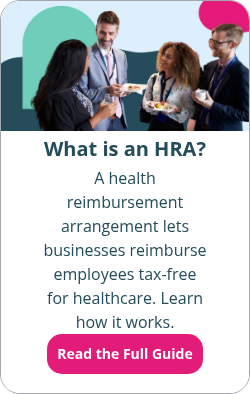What is comprehensive health insurance coverage?
By Holly Bengfort on November 26, 2025 at 1:20 PM
When choosing a health plan, many employers and employees look for one that goes beyond the basics. That’s where comprehensive health insurance coverage comes in. Comprehensive coverage protects individuals from high medical costs by covering a broad range of healthcare services, helping people get the care they need without unexpected financial surprises.
In this article, we’ll break down what comprehensive coverage includes, how it works, and why it matters for organizations exploring personalized benefits solutions, like a health reimbursement arrangement (HRA).
In this blog post, you'll learn:
- What services insurers typically include in comprehensive coverage.
- What services comprehensive coverage doesn’t include.
- How employers can provide access to comprehensive coverage by offering an HRA.
What does comprehensive health coverage mean?
Comprehensive health insurance, also known as major medical health insurance, provides extensive protection across a wide range of medical services, from routine preventive care to major medical events.
Unlike limited-benefit or supplemental plans, which only cover specific conditions or services, comprehensive plans aim to cover most essential healthcare needs.
Individual and small group comprehensive health insurance plans must cover the Affordable Care Act’s (ACA) 10 essential health benefits at no cost:
- Preventive care (annual checkups, screenings, immunizations)
- Prescription drugs
- Maternity and newborn care
- Mental health services and substance use disorder treatment
- Emergency services
- Ambulatory services
- Hospitalization
- Lab tests and imaging
- Rehabilitative and habilitative services
- Pediatric services
While large group health plans don’t necessarily have to cover the essential health benefits. But if they do, there are rules they must follow. Under the Public Health Services Act section 27111, group and individual plans can’t impose lifetime or annual dollar limits on any essential health benefits they cover. However, the ACA requires all “non-grandfathered” group and individual plans to cover preventive care without cost-sharing.
Even if a large group plan or a self-insured plan doesn’t have to cover the EHBs, most comprehensive health plans do.
What comprehensive coverage doesn’t include
While comprehensive coverage is extensive, it isn’t unlimited.
Most health plans don’t cover:
- Cosmetic procedures
- Vision or dental for adults (these often require separate plans)
- Fertility treatments
- Long-term care
- Alternative therapies
It’s important for employers and employees to review plan documents to understand what is and isn’t included.
What health plans offer comprehensive coverage?
Various types of health plans provide comprehensive coverage, including:
- Most employer-sponsored health plans
- ACA marketplace plans
- ACA-compliant plans purchased off-exchange
- Medicaid and CHIP plans
- Medicare (either Original Medicare or Medicare Advantage)
- Most grandmothered and grandfathered major medical plans
Why comprehensive coverage matters for employers
PeopleKeep’s 2024 Employee Benefits Survey found that 81% of employees consider an employer’s benefits package a key factor when deciding whether to accept a job. Health benefits stand out even more, with 92% of employees saying they’re an important part of that package.
Offering comprehensive health insurance can help employers:
- Attract and retain talent with competitive benefits.
- Protect employees financially from high medical costs.
- Support preventive and ongoing care for a healthier workforce.
- Provide predictable healthcare spending with clear out-of-pocket limits.
But for many organizations, especially small businesses, the rising cost of group health insurance can make comprehensive plans feel out of reach.
That’s where stand-alone HRAs come in.
How HRAs help employers provide access to comprehensive coverage
A stand-alone health reimbursement arrangement (HRA), sometimes mistakenly referred to as a health reimbursement account, allows employers to reimburse employees tax-free for their individual health insurance premiums and more than 200 eligible out-of-pocket expenses.
Some of those eligible expenses include:
- Doctor visits
- Prescription medication
- Over-the-counter medication
- Mental health counseling
Unlike a health savings account (HSA), only the employer funds an HRA. You set an allowance for your employees to spend on their own health plans instead of purchasing one for them. This way, you can provide access to comprehensive coverage without administering a traditional group plan.
The two most popular stand-alone HRAs are:
- The individual coverage HRA (ICHRA): ICHRAs work for employers of all sizes. They can vary allowances and eligibility using 11 employee classes, or by employee age or family size. With no annual limits on contributions, employers can offer as much as they would like for health insurance.
- The qualified small employer HRA (QSEHRA): Unlike the ICHRA, the QSEHRA is only for employers with fewer than 50 full-time equivalent employees (FTEs). They can vary allowances by employee age and family size. There are annual limits on employer contributions with a QSEHRA.
The employer gets cost control and predictability, as they’ll never spend more than their offered allowance. Plus, employees get to choose the plan that best fits their needs.
Conclusion
Comprehensive health insurance plans give employees peace of mind by covering a full scope of essential medical services and protecting them from major financial risk. While traditional group insurance is one way to provide comprehensive benefits, cost barriers can make it challenging, especially for small and mid-sized organizations.
HRAs provide an affordable and customizable alternative that empowers employees to choose the comprehensive plan that best suits their needs, while helping employers remain competitive and cost-effective.
To get started with offering a QSEHRA or ICHRA at your organization, contact a PeopleKeep HRA specialist. We’ll help you understand your options and design a benefit that works for your needs.
Check out more resources
See these related articles

What to do when your group health insurance premiums go up
Dealing with a health insurance premium increase? This guide has you covered with tips and strategies to navigate changes and keep your coverage affordable.

What can an HRA reimburse?
Wondering if your HRA can cover specific medical costs? Discover the comprehensive list of eligible expenses that your HRA can reimburse in this article.

What is an ICHRA?
What is an ICHRA, and how does it work? Find out everything you need to know about this innovative healthcare option: the individual coverage HRA.



